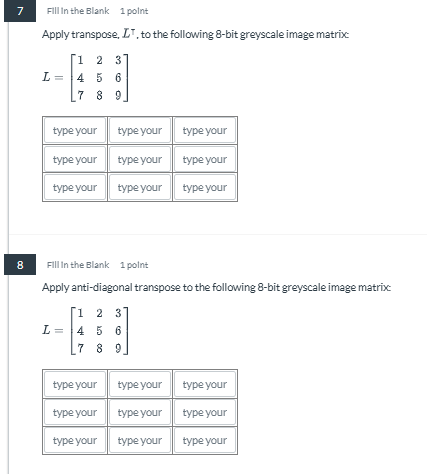Apply transpose L^T to the following 8-bit grayscale image matrix L = [[1, 2, 3], [4, 5, 6], [7, 8, 9]].

Understand the Problem
The question is asking to perform matrix operations, specifically the transpose of a given 8-bit grayscale image matrix. This involves rearranging the rows and columns of the matrix based on the transpose operation.
Answer
For transpose: $$ L^T = \begin{pmatrix} 1 & 4 & 7 \\ 2 & 5 & 8 \\ 3 & 6 & 9 \end{pmatrix} $$ For anti-diagonal transpose: $$ L^{\text{anti}} = \begin{pmatrix} 3 & 6 & 9 \\ 2 & 5 & 8 \\ 1 & 4 & 7 \end{pmatrix} $$
Answer for screen readers
For the transpose ( L^T ):
$$ L^T = \begin{pmatrix} 1 & 4 & 7 \ 2 & 5 & 8 \ 3 & 6 & 9 \end{pmatrix} $$
For the anti-diagonal transpose ( L^{\text{anti}} ):
$$ L^{\text{anti}} = \begin{pmatrix} 3 & 6 & 9 \ 2 & 5 & 8 \ 1 & 4 & 7 \end{pmatrix} $$
Steps to Solve
- Understanding Transpose Operation
The transpose of a matrix is obtained by swapping rows with columns. For a matrix ( L ), the element at position ( (i, j) ) becomes the element at position ( (j, i) ).
- Transpose the Given Matrix
Given the matrix ( L ):
$$ L = \begin{pmatrix} 1 & 2 & 3 \ 4 & 5 & 6 \ 7 & 8 & 9 \end{pmatrix} $$
The transposed matrix ( L^T ) becomes:
$$ L^T = \begin{pmatrix} 1 & 4 & 7 \ 2 & 5 & 8 \ 3 & 6 & 9 \end{pmatrix} $$
- Understanding Anti-Diagonal Transpose Operation
The anti-diagonal transpose (or reverse transpose) swaps rows and columns in a way that the last element of a row goes to the first column of a new row.
- Apply Anti-Diagonal to the Given Matrix
Starting with matrix ( L ):
$$ L = \begin{pmatrix} 1 & 2 & 3 \ 4 & 5 & 6 \ 7 & 8 & 9 \end{pmatrix} $$
The anti-diagonal transposed matrix ( L^{\text{anti}} ) becomes:
$$ L^{\text{anti}} = \begin{pmatrix} 3 & 6 & 9 \ 2 & 5 & 8 \ 1 & 4 & 7 \end{pmatrix} $$
For the transpose ( L^T ):
$$ L^T = \begin{pmatrix} 1 & 4 & 7 \ 2 & 5 & 8 \ 3 & 6 & 9 \end{pmatrix} $$
For the anti-diagonal transpose ( L^{\text{anti}} ):
$$ L^{\text{anti}} = \begin{pmatrix} 3 & 6 & 9 \ 2 & 5 & 8 \ 1 & 4 & 7 \end{pmatrix} $$
More Information
The transpose operation is often used in various fields such as computer graphics and image processing, especially when working with image matrices for transformations. The anti-diagonal transpose creates a flipping effect that can also be important in certain algorithms.
Tips
- Confusing Transpose and Anti-Diagonal Transpose: Ensure you know the difference. The transpose swaps rows with columns, while the anti-diagonal transpose flips the matrix.
- Misplacing Elements: Double-check positions when swapping; keep track of the original locations of elements in the matrix.
AI-generated content may contain errors. Please verify critical information